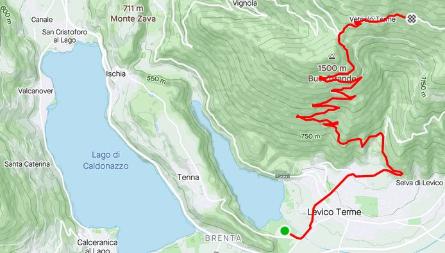Kwiggle folding bike in the Alps
The ultimate racing bike vs. Kwiggle comparison in the mountains
I wanted to know how the 6-speed Kwiggle performs in the mountains. That's why I did a road bike-Kwiggle comparison in the Alps:
14 km (8.7 mi.) and 1,000 metres (3280 ft.) of altitude, in the morning with the road bike, in the afternoon with the Kwiggle with climbs between 7 and 12%
My conclusion: The Kwiggle is almost better uphill than a road bike. But the best part was the Kwiggle downhill ride at up to 60 km/h (37.3 mph), in slalom mode:
It was the most beautiful bike riding experience of my life.
Such downhill rides underline the high quality of the Kwiggle: precise running accuracy, wear-resistant rims, no fidgeting at the wheel.


You can also view details of the ride on Strava:
Uphill with the racing bike:
https://www.strava.com/activities/3810159307
I wanted to ride the route on the racing bike first so as not to give the Kwiggle an advantage. After a little break, I wanted to ride the same route with the Kwiggle. It was mercilessly uphill the whole time, always between 6 and 12% gradient 14 km (8.7 mi.) long.
At the halfway point came the steepest sections. I almost wanted to give up: a few times I even felt a bit sick because of the circulatory strain. My pulse was between 160-170 beats per minute. It worked out in the end, but it felt really borderline. I rode in the lowest gear for almost the whole distance.
One thing became very clear, and every mountain biker will certainly be able to confirm this: when riding uphill on a racing bike, there is always the conflict between riding standing up, which puts more pressure on the pedals, but you have to keep lifting your weight onto the pedal, and riding sitting down: this is more comfortable, but requires more effort from the thigh and with a hunched back. This conflict is possibly solved by the Kwiggle.
Downhill with the racing bike:
https://www.strava.com/activities/3810250787
A beautiful downhill run where you can also let things go. But when I reached the bottom, I was exhausted and slept for an hour. Then I had to regenerate another 3 hours, before I was ready to take the Kwiggle uphill.
Uphill with the Kwiggle:
https://www.strava.com/activities/3811394246
Second climb of the day: slightly slower overall than on the racing bike in the morning. The smallest Kwiggle gear is about the same in effect as the second smallest racing bike gear. The route is still doable with the 6-speed Kwiggle, but a slightly smaller gear would be even better from 11% gradient onwards. Compared to the climb on the road bike in the morning, the Kwiggle climb was less strenuous, the pulse rate was 150-160/min.
My conclusion: Since you ride the Kwiggle in standing-sitting mode and the saddle lifts you in an upright position up onto the pedals, the conflict between standing and sitting no longer exists. This makes riding the Kwiggle up the mountains more relaxed than on a racing bike.
My tip for in the mountains: the further the saddle is placed forward, the easier it becomes. So if you ride the Kwiggle in the mountains, always place the saddle a bit more forward, so that the pressure on the pedals can continue to come from above. If necessary, also set the saddle a little bit more inclined, then you will ride a little more leaning forward.
Downhill with the Kwiggle:
https://www.strava.com/activities/3811597941
This was by far the best experience of the whole day. With 50 - 60 km/h (31 - 37 mph) with the Kwiggle in slalom mode downhill. I have never had such a beautiful downhill experience. It sounds crazy, but the downhill felt safer on the Kwiggle than on the racing bike: the road surface was good to very good, and with the industrial bearings,
precisely running rims and absolute running smoothness of the wheels and due to the position of the front wheel there was absolutely no shaking at the handlebars.
Because of the short wheelbase, you can achieve high cornering speeds with the Kwiggle. I even overtook cars. When I arrived I was really refreshed - of course also because of the great experience - and that night I allowed myself a delicious pizza at the pizzeria.
My conclusion of the day: the Kwiggle has advantages in the climb and makes the descent really fun. Now, not everyone will dare to do something like this with the small wheels, especially if he is not yet so proficient with the Kwiggle. But the physiological advantages make the Kwiggle a real fun fitness bike for the mountains.